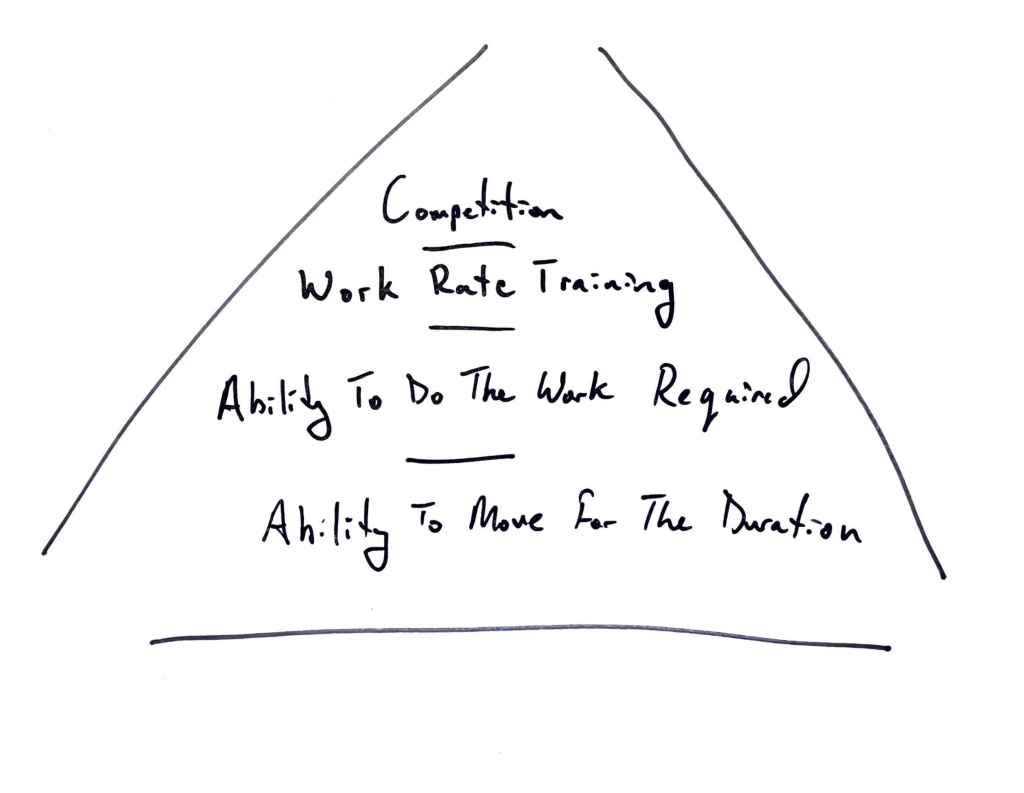
Every new cyclist knows the feeling of being completely blown after a hard effort.
In my first bike race, I decided to attack the bunch, downhill. Don’t ask me why. Back then, I’d lose my mind when my HR was up.
The attack left my legs shattered and saw me quickly spat out the back when the bunch rolled me up.
In swimming, as I challenged my ability to swim long via 4000, 5000, 6500 and, eventually, 10000 meter workouts, there would be days when a switch-flipped and, instantly, my pace dropped by 10s per 100.
Like my first bike race, there was no coming back.
In running, particularly long races, my experience was different yet again.
Here, pain would slowly build in in my legs and my pace would gradually slow.
Eventually, my legs would be so beat up, I was unable to place a meaningful load on my cardiovascular system.
Fueled up, and hydrated, with no ability to raise my heart rate.
- What’s happening?
- What can we do about it?
Exercise physiologists refer to the above as Durability
…the time of onset and magnitude of deterioration of physiological performance parameters over time during prolonged exercise.
– TTS Podcast with ed maunder & stephen Seiler
Quite a mouthful.
I prefer to think in terms of DEPTH.
Think Deep.
Deep Fitness
- goes from our skin into our bones
- permeates every cell of our bodies
- can’t be disturbed by shocks
- in pace
- from heat
- via altitude
- over time
Fitness, that goes the distance.
Fitness, nurtured with sleep and nutrition.
How might we build this fitness?
Last Monday, I shared an Endurance Hierarchy
- Ability to Move
- Ability To Do Work
- Work Rate Training
- Specific Preparation for Competition

Before you try to get faster, DEEPEN the fitness you already have.
You are going to be surprised by this process.
It will make you faster AND give you the capability to hold your speed.
Dead-simple approach
- Time at Aerobic Threshold
- Heavy Domain Sets, where you ‘recover’ at Aerobic Threshold
Make sure you’ve developed the Ability To Do Work before starting this training.
How much should you do? Start with a 90:10 split.
If you incorporate hills then you might already be doing this training without realizing it.
That said, if you are ‘trying’ on your hills then you are likely to be training more intensely than required.
This tip, to slow down, will be a recurring form of my advice to you.
++
Skew Errors Left
You’re almost certainly training more intensely than you realize.
It’s not your fault. It’s the way we’re wired.
The solution is simple, aim your mistakes towards “low & less.”
In the unlikely event you’re aiming too low, you get more volume around aerobic threshold.
This is not a problem, it’s a benefit from my approach.
You’ll benefit in avoiding the common pitfall of nuking yourself as soon as you add a bit of “proper” training.
++
What is a Heavy Domain set?
I’ve written out examples for you.
- Swim – Pace Change Workouts
- Bike – Big Gear and Favorite Endurance Patterns
- Run – Favorite Endurance Patterns
Tips for all sports:
- Start with 10-15 minutes of work, broken.
- Be patient with getting your heart rate up, there’s a lag.
- Learn to recover while moving at aerobic threshold pace
Advanced athletes, build up to 40-60 minutes worth of work, broken.
Remember: this is not more than 10% of your total volume
Resist: the urge to go bananas when heart rate rises
Know: The big gains come from:
- The 90% => time around Aerobic Threshold
- Sleep
- Nutrition
- Stacking continuous work (1000 Day Pacing)
- Workout by workout
- Week by week
- Month by month
- Season by season
Build fitness that permeates every cell of your body.
Think DEEP
Linked Resources
- Podcast: Scientific Triathlon: Durability
- Article: Aerobic Threshold & Threshold-Minus
- Article: Endurance Hierarchy
- Article: Allocating Intensity
- Video: Why You Are Training More Intensely Than You Realize
- Article: Human OS & The Endurance Athlete
- Thread: Free Training Resources
In January, I am migrating to Substack and splitting my blog.
- Endurance Essentials : My next book, written online (to start)
- True Wealth : My family & finance writing
WordPress won’t let me migrate my existing subscribers.
Subscription is free – there’s an option to financially contribute if you wish.
Come along for the ride. It’s going to be great.












You must be logged in to post a comment.